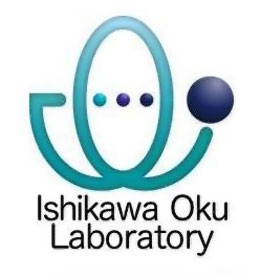
Ishikawa Watanabe Laboratory (formerly know as Ishikawa Oku Lab)
In June of 1989, Dr. Masatoshi Ishikawa became an associate professor of the University of Tokyo’s School of Engineering and has started researching on the field of Sensor Fusion, Optical Computing, Tactile Sensor and Parallel Vision. It was not until April, 1997, however, that the Ishikawa Laboratory was officially established and Dr. Ishikawa became the professor.
In April 2000 the lab’s name was changed to Ishikawa Hashimoto Laboratory after Dr. Koichi Hashimoto became an associate professor. During this time, the Visual servo group inside this lab has also started. Four years later, the lab changed its name to Ishikawa Namiki after Dr. Aiko Namiki became an assistant professor and lecturer while Prof. Ishikawa was promoted as the president of the University of Tokyo.
A year later, Dr. Takashi Komuro joined the lab as an Assistant professor and lecturer together with Dr. Hiromasa Oku as its assistant professor/research associate. The lab was named as Ishikawa Namiki Komoru Laboratory.
In 2008, the lab changed its name once again after Akio Namiki transferred to Chiba University, this time the lab was known as the Ishikawa Komuro Laboratory. It was not until April of 2011 that the lab was named as Ishikawa Oku Laboratory after Hiromasa Oku became the school’s assistant professor and research associate. In July 2014 it was renamed as Ishikawa Watanabe Laboratory.
Today, the lab’s major research programs can be divided into four major categories: Sensor Fusion, Dynamic Image Control, Vision Architecture and Meta Perception. Among its recent research projects includes the creation of Harmonized Dynamic Information Environment Based on High Speed Sensor Technology, the development of High speed Intelligent Robots with the help of Ultra High Speed Vision, Bidirectional Recognition between objects and environment through the use of Networked High Speed Vision, the Advanced Vision and Control for Intelligent Autonomous Systems, and the Active Projection using High Speed Optical Systems among others.
Older researches that the Ishikawa Watanabe Laboratory have undertaken includes a High speed Gaze Control System using Actuated Mirrors, High speed Book Scanning Systems, High speed Adaptive 3 Dimensional sensing and Reconstruction of 3 Dimensional Images, and a lot more.
With the construction of models and engineering systems like parallelism, the group hopes that people can expect a better understanding of the real world and enhanced performance of systems when used for practical applications.